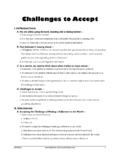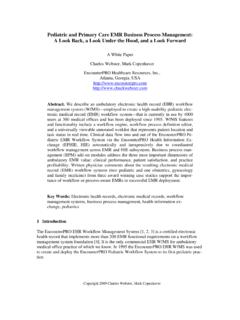Transcription of The Path Forward - Education in the United States
1 The path ForwardThe Future of Graduate Education in the United StatesExecutive SummaryGraduate School Enrollment Who Enrolls?Overall enrollment in colleges and graduate schools continues to increase, but the gains have not kept pace with the increase in the general population of individuals of college age. Growth in graduate school enrollment also is complicated by the dropout problem at both the high school and undergraduate levels. Among those who do complete high school, data indicate that only slightly more than half enroll in some type of postsecondary Education , and great disparities remain in enrollment levels by ethnicity and race. While the majority of Asian and White non-Hispanic high school graduates enroll in some type of college, less than half of Black and Hispanic high school graduates continue on to either a 2-year or 4-year Demographics for Graduate EducationThe population is diverse and continues to grow even more so.
2 A number of emerging sociological and economic forces will present challenges to the entire educational system, including graduate Education . Demographic shifts are likely to result in a population with less Education than today and lower math and reading skill levels. As a result, the population of domestic students eligible to pursue higher Education is likely to become more diverse but possibly less academically skilled. International migration will account for more than half of the nation s population growth by the year 2015, according to Census Bureau estimates. More first-generation college students will emerge from this pool, and many are likely to require additional educational preparation. The number of nontraditional students is growing. They are older, engage in work, family, and school activities at the same time, and may view graduate Education not as a means of preparing for a first career but rather as a means of changing or improving their path Forward : The Future of Graduate Education in the United StatesFigure 1.
3 Who goes to college?Source: Davis, W. J., & Bauman, K. J. (2008). School enrollment in the United States : 2006. Washington, DC: Census innovative solutions to many of the challenges facing the United States and the world in the 21st century will depend upon a creative, knowledgeable, and highly skilled workforce. The application of knowledge and skills to these challenges will help maintain our country s future economic prosperity and growth, foster social well-being, and assure our leadership position in the global economy. Undergraduate Education is important to the creation of a stable economy because it provides students with foundational knowledge and work skills and prepares college graduates for a wide range of employment options. But it is graduate Education that provides students with the advanced knowledge and skills that will secure our future intellectual leadership in the knowledge economy.
4 Our key assumption is that the competitiveness of the United States and our nation s capacity for innovation hinge fundamentally on a strong system of graduate graduate Education system has served our nation well. But the system also faces considerable challenges. Many undergraduate degree holders who have the ability to obtain a graduate degree never enroll in a graduate program, and many who do enroll leave without a degree. The demographics of tomorrow s domestic population eligible for graduate study will look very different from today s, with possible implications for how graduate study is structured, supported, and evaluated. Other nations are moving decisively to build strong graduate programs to attract the world s best students whose interest in graduate study we have long taken for of Vulnerability Increasing numbers of individuals are returning to graduate school after having spent time in the workforce.
5 The current economy contributes to this trend; a growing number of career changers or laid-off workers are looking to graduate educa-tion in hopes that an advanced degree will ensure continued employability and/or career changes point to the need to reconsider how graduate students are financially supported as well as what kinds of additional resources they may need to succeed in graduate study. The changing demographics also may require a reconsideration of traditional time-to-degree expectations and career pathway Completes Graduate Degrees?A number of other serious challenges face the graduate system. These include: Degree completion: Despite the rigorous selection processes used for admissions into graduate schools and the high achievement level of those pursuing a graduate degree, some studies indicate that the attrition rate in doctoral Education is as high as 40% to 50%.
6 Why do students not complete their degrees? At the doctoral level, factors include a change in family status, full or part-time enrollment status, job/military commitments, needing to work, or dissatisfaction with the particular program. Time to degree completion is lengthy, especially for those in doctoral programs. There is no fixed time appropriate for every degree, and there always will be a range of average times to degree based on different requirements in different fields. Still, the public and private costs of a longer-than-necessary time to degree completion, and the benefits to the public and to the individual recipient of a degree awarded, mean that students should complete as efficiently as possible. The Council of Graduate Schools Completion Project shows that less than 25% of students completed degrees within 5 years, and only about 45% completed within 7 years.
7 Changes Influencing Workforce NeedsIt is projected that about million jobs will require a master s, doctoral, or advanced degree between 2008 and 2018. While many master s programs are geared toward the needs of the workplace and prepare students for careers in the business, government, and nonprofit sectors, this is not necessarily true at the doctoral level. The expected career path for doctoral recipients is less straightforward than for master s graduates. Changes in the availability of tenure track positions in academia may influence the career path for doctoral students. An academic position in higher Education that leads to tenure has, in the past, been an important career incentive for many students pursuing a doctoral degree. Today, however, an increasing number of nontenured and adjunct faculty are being hired over those in tenure track positions, and many doctoral recipients are looking for ways to serve society in careers outside academia.
8 International changes in higher Education also challenge the graduate system. For many years the United States led the world in attracting international students to graduate programs. Cultural changes have resulted in increased access to higher Education in many countries, and systemic changes in Europe have resulted in more unified and consistent standards. Political and economic changes have placed a focus on the economic benefits of a highly trained workforce, leading to greater competi-tion among countries for available students. The growing reputation of international graduate programs means that while graduate schools have always provided the highest-quality graduate Education , the quality of graduate programs outside the United States is growing as 2. Doctoral completion rate, by field and number of : Council of Graduate Schools.
9 (2008). completion and attrition: Analysis of baseline program data from the Completion Project. Washington, DC: Areas of VulnerabilityAddressing vulnerabilities in our graduate Education system now will strengthen not only graduate Education , but also our capacity for innovation and our ability to compete in the global economy. Changes in the university, industry, and government arenas are called graduate Education is a strategic national asset. Like all valuable assets it must be attended to and nurtured in order to remain viable and strong. Strengthening higher Education and specifically graduate Education is an investment in our future. In order to ensure a strong graduate Education system going Forward , universities need to address a number of challenges. Continuing efforts to identify and attract talented students to graduate Education are critical.
10 Improving student completion rates is important. Institutions must review and analyze their own completion and attrition patterns at both the master s and doctoral levels and create interventions to increase completion. Nonacademic career pathways for graduate students must be clarified and expanded upon. Graduate schools must provide appropriate training, mentoring, and information about career opportunities outside academia ( , business, government, and the nonprofit sector) in addition to those in academia. Preparing future faculty also is critical. Technology and demographics are changing, our understanding of how students learn is improving, and the aging of the professoriate has implications for how future faculty are prepared in graduate schools. A professional development component is one of the strengths of graduate Education .








